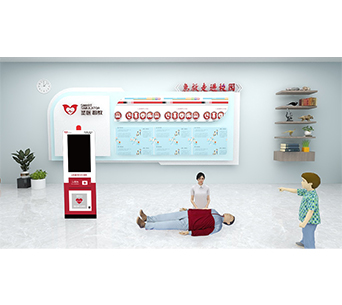■ The system mainly consists of a CPR all-in-one machine, a simulated AED, and a CPR simulator, all of which interact with each other wirelessly, suitable for different application scenarios and convenient for mobility.
■ The first aid all-in-one machine stores first aid kits and simulated AEDs, which can be used for simulation training and assessment of first aid rescue.
■ Adult males as a whole have clear anatomical landmarks, realistic nipples and xiphoid processes, making it easy to operate and locate. The head can rotate 180 degrees left and right, and the jaw joint can move.
■ Simulate the accurate anatomical position of the human head and neck, with the head able to swing left and right and rotate horizontally 180 degrees, making it easy to remove oral foreign objects.
■ The eyeball adopts OLED simulation, with visible colored retina, black pupils, transparent crystals, and the ability to reflect light at any angle.
■ Palpable carotid artery pulsation, in a state of death, carotid artery pulsation disappears.
■ The simulator person has multiple pressure position sensing points on the chest, which can monitor the position of hand pressure on the chest in real time (left, right, top, bottom, moderate).
■ The cardiopulmonary resuscitation all-in-one machine includes theoretical teaching and video explanations for cardiopulmonary resuscitation, trauma first aid, emergency rescue, and emergency events.
* First aid for trauma includes methods of hemostasis, bandaging, fracture fixation, and food poisoning.
* Emergency operations for emergencies including gas poisoning, electric shock, drowning, and heatstroke.
* Emergency rescue includes emergency shock, airway obstruction, and food poisoning.
■ CPR provides two mode options: training mode and assessment mode. The training mode includes compression only, ventilation only, and compression ventilation training, with corresponding voice prompts. There are two ways to display the pressing depth and tidal volume: waveform and bar charts. The point marked method is used to record whether the frequency of each pressing is within the standard range, visually displaying the specific situation of each pressing and blowing.

■ CPR parameters can be adjusted according to training assessment needs, including CPR operation time, number of cycles, pressing depth, pressing frequency, pressing compliance rate, blowing volume, blowing compliance rate, etc.
■ The system can train and assess CPR and AED separately, automatically detect whether the electrode is connected, and when the defibrillation is correct, the control end receives the defibrillation energy value and records the number of defibrillations, generating a transcript.

■ Comply with AHA operation procedures: assess environmental safety, assess awareness, check respiratory and carotid arteries, perform pupil examination, emergency call for help, open airway, and remove oral foreign objects. Consciousness assessment, pulse check, airway opening, and pupil examination are automatically fed back into the system and a transcript is generated.
■ Candidate information input: Candidate's student ID and name.
■ Operational statistics: assess environmental safety, pat and call, assess breathing and carotid arteries, call for help, open airway, remove oral foreign objects, use AED, correct blowing rate, number of blowing errors, analysis of blowing errors (too large, too small, too much, too little), correct pressing rate, number of pressing errors, analysis of pressing errors (too large, too small, too much, too little, position error, incomplete rebound of pressing), incorrect pressing frequency The pressing interval is too large.









